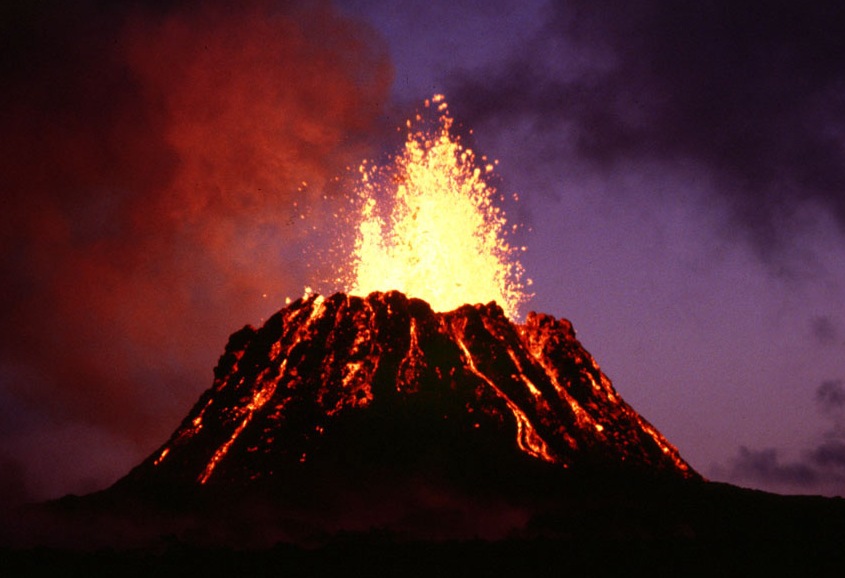Nothing on Earth has more awesome might than a volcano. Eruptive, hot, and violent, volcanoes have the ability and the power to shape, mold, create, and destroy our landscape, whether directly or indirectly. Volcanoes are typically mountains, hills, or bowls, but always include ruptures in Earth's crust that allows magma from the mantle to get through.
Ever wonder why there are no volcanoes hanging around New York or London? It's all because of plate tectonics. Volcanoes are located on major diverging and converging fault lines, or at hot spots. Neither are anywhere near New York or London, or the entire eastern United States for that matter. They can be found in western Europe, but not near the UK.
One way to think of volcanoes, although not a pretty way, is as a zit. The Earth's crust is like your skin, and a volcano is a zit. The same way you squeeze your zit to pop it, pressure from the heat squeezes magma under the crust until it becomes too much, and the volcano erupts. I know that wasn't a pretty analogy, but it works.
We tend to think of volcanoes as cone-shaped mountains that spew lava, but there are actually a few different types. Cinder cone volcanoes are the most common type and are the smallest. Stratovolcanoes look like cones, but are much larger, rising up to 8,000 feet. Stratovolcanoes typically have the most violent eruptions. Shield volcanoes are gently sloping and are typically several miles in diameter. Calderas are bowl-shaped depressions. They do not look like your average volcano and typically form from previous catastrophic eruptions.
We tend to think of volcanoes as cone-shaped mountains that spew lava, but there are actually a few different types. Cinder cone volcanoes are the most common type and are the smallest. Stratovolcanoes look like cones, but are much larger, rising up to 8,000 feet. Stratovolcanoes typically have the most violent eruptions. Shield volcanoes are gently sloping and are typically several miles in diameter. Calderas are bowl-shaped depressions. They do not look like your average volcano and typically form from previous catastrophic eruptions.
Over 70 percent of the Earth is covered in ocean, yet we tend to forget what's under it. Volcanoes are not restricted to land; there are undersea volcanoes as well. Those undersea volcanoes are how Hawaii and many other sea islands were and are formed. Just last year a new island was formed in the South Pacific thanks to the eruption on an undersea volcano called Hunga Tonga.
*TIME, Active Wild, Live Science, BBC News, Do Something, Universe Today, Wikipedia, Space, Extreme Iceland
Volcanic eruptions have shaped our planet over time. Mount Vesuvius is a famous volcano in Italy that has erupted at least 30 times. Vesuvius buried the famous ancient city of Pompeii in 79 AD. Krakatoa erupted in 1883 in Indonesia with the power of 13,000 atomic bombs. Krakatoa's explosion is considered the loudest sound in history and was heard over 3,000 miles away on the African coast. Krakatoa's explosion was so powerful, it was suicide. The original volcano ended up sliding into the ocean. Mauna Loa, the worlds largest volcano, is a synonym for Hawaii. Mauna Loa is located in the middle of Hawaii's Big Island and is 13,700 feet high and last erupted in 1984. The city of Hilo, Hawaii is partly built on 19th century lava flows from Mauna Loa. Eyjafjallajokull is a volcano in Iceland that erupted in 2010 and cost the airline industry over $1 billion in interruptions. Mount Pelee in the Caribbean erupted in 1902 and miraculously killed 29,933 of the island's 29,937 residents.
Mount Saint Helens is arguably the most famous volcano in the United States. Mount St Helens' last eruption was in 1980, so many Generation Xers and Baby Boomers likely remember it well. Geologists were aware that Mount Saint Helens would likely soon erupt, but they were not aware that it would be caused by a 5.1 magnitude earthquake, which created a landslide on the volcano, allowing built up pressure to escape and the volcano to erupt. The Mount Saint Helens eruption was so spectacular that the northern face of the mountain was blown off. Mount Saint Helens' elevation dropped from 9,677 feet to 8,363 feet. Mount Saint Helens also produced the worlds largest landslide.
Other famous volcanoes include Mount Fuji, Mount Rainier, Mauna Kea, Mount Tambora, Cotopaxi, and Yellowstone.
Yellowstone does not look like your average volcano. It is actually a caldera shaped supervolcano. Legend has it that a Yellowstone eruption could wipe out all life on Earth. It turns out that that is false, but that doesn't mean that an eruption wouldn't come with consequences. A Yellowstone eruption would be catastrophic for the world's health, agriculture, economy, and climate: Earth's average temperature could drop for a decade. Luckily, this is something we likely will not see in our lifetimes.
And volcanoes are not restricted to Earth either. The largest volcano in the Solar System can actually be found on Mars: Olympus Mons. Olympus Mars is an estimated 72,000 feet high, or 13.6 miles, and is around the same size as Arizona.
Volcanoes are interesting things. They can create lightning, trigger tsunamis, mudslides, and even earthquakes, and they have the ability to change our climate. Some volcanoes erupt every millions of years, while others have been continuously erupting. Every day there are an estimated 20 volcanoes erupting at once, with the majority happening under the ocean.
If you're ever in Iceland and have $400 to spare, you can even join a tour and go inside a volcano. Now that's what you call hands on.
*TIME, Active Wild, Live Science, BBC News, Do Something, Universe Today, Wikipedia, Space, Extreme Iceland

No comments:
Post a Comment